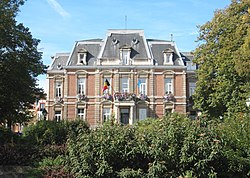This article needs additional citations for verification. Please help improve this articlebyadding citations to reliable sources. Unsourced material may be challenged and removed.
Find sources: "Uccle" – news · newspapers · books · scholar · JSTOR (September 2010) (Learn how and when to remove this message) |
Uccle (French, pronounced [ykl]) or Ukkel (Dutch, pronounced [ˈʏkəl] ⓘ) is one of the 19 municipalities of the Brussels-Capital Region, Belgium. Located in the southern part of the region, it is bordered by the City of Brussels, Forest, Ixelles, and Watermael-Boitsfort, as well as the Flemish municipalities of Drogenbos, Linkebeek and Sint-Genesius-Rode. In common with all of Brussels' municipalities, it is legally bilingual (French–Dutch).
Uccle
| |
|---|---|

Uccle's Municipal Hall
| |
Location of | |
| Coordinates: 50°48′N 04°20′E / 50.800°N 4.333°E / 50.800; 4.333 | |
| Country | |
| Community | Flemish Community French Community |
| Region | Brussels-Capital |
| Arrondissement | Brussels-Capital |
| Government | |
| • Mayor | Boris Dilliès [fr], (MR) |
| • Governing party/ies | MR, Ecolo, Les Engagés |
| Area | |
| • Total | 22.87 km2 (8.83 sq mi) |
| Population
(2020-01-01)[1]
| |
| • Total | 83,980 |
| • Density | 3,700/km2 (9,500/sq mi) |
| Postal codes |
1180
|
| NIS code |
21016
|
| Area codes | 02 |
| Website | www.uccle.be/fr (in French) www.uccle.be/nl (in Dutch) |
As of 1 January 2022[update], the municipality had a population of 85,099 inhabitants. The total area is 22.87 km2 (8.83 sq mi), which gives a population density of 3,720/km2 (9,600/sq mi), half the average of Brussels. It is generally considered an affluent area of the region, and is particularly noted for its community of French immigrants.
According to legend, Uccle's Church of St. Peter was dedicated by Pope Leo III in the year 803, with Charlemagne and Gerbald, Bishop of Liège, attending the ceremony. During the following centuries, several noble families built their manors and took residency there. The first mention of the name Woluesdal, now evolved into Wolvendael, dates from 1209. In 1467, Isabella of Portugal, wife of Philip the Good, Duke of Burgundy, founded a Franciscan convent on Uccle's territory. Later, Uccle became the judiciary capital of the area including Brussels. Throughout the early stages of its history, however, the village of Uccle always had a predominantly rural character and lived mostly from the products of forestry and agriculture.
A large part of the territory of modern-day Uccle used to be part of the Lordship (seigneurie) of Stalle, in addition to the old village of Uccle and the barony of Carloo.
The first Lords of Stalle (High Justiciaries) were:[2] Henri de Stalle, knight (died before 1357); Florent de Stalle, his son, alderman of Brussels in 1319 and knight. He married Lady Aleyde; and Florent de Stalle, knight and alderman of Brussels in 1357, member of the Seven Noble Houses of Brussels. It was he who, with his brother Daniel, founded the Stalle chapel and gave it lands.
Dependent fiefs of the Lordship of Stalle included the Fief of Overhem and the Fief of the Roetaert. The Fief of Overhem was located between the Dieweg and Stalle, it had a manor, a mill called Clipmolen, woods, and pasture. However, in 1465, Marguerite Hinckaert wife of Louis de Mailly, obtained from the sovereign the annexation of this fief to the Lordship of Stalle. The Fief of the Roetaert was located in Neerstalle, between the Kersbeek woods and the Ukkelbeek. Its surface amounted to 39.78 acres of land and meadows and it included the manor of Roetaert.[3][a]
At the end of the 18th century, a few years after the French Revolution, Uccle merged with neighbouring territories to become a municipality, with its own burgomaster (mayor) and municipal assembly. It had to wait until 1828, however, for the Dutch authorities to allow the construction of the first Municipal Hall. This was a time of economic prosperity and growth, stimulated by the proximity to the two main roads linking Brussels to the industrial south. A newer and larger Municipal Hall was built between 1872 and 1882. Banker and philanthropist Georges Brugmann was instrumental in the urbanisation of the municipality just before the turn of the 20th century. In the early 20th century, Michel van Gelder introduced a new breed of chicken, the d'Uccle, named after the town. Despite the accelerated rate of construction that took place in the early 20th century, Uccle succeeded in keeping several of its green areas intact, which now attract many of the Brussels area's wealthier inhabitants.
Lying beyond Forest and Ixelles and skirting the Sonian Forest, Uccle is Brussel's largest and southernmost municipality. Large 19th- and 20th-century villas with generous gardens make this green and calm suburb a favourite with well-off expatriates, with the Art Deco area around the Royal Observatory of Belgium and the fringes of the Sonian Forest the two most desirable addresses.
Uccle is mainly a residential area but has a lot of parks and forested areas, such as the Wolvendael Park and the Verrewinkel Woods. Wolvendael is the site of a 1763 castle, owned by a number of notable aristocrats from the 18th and 19th centuries. The municipality is also situated to the immediate west of the Bois de la Cambre/Ter Kamerenbos. The Place de Saint-Job/Sint-Jobsplein and the area near St. Peter's Church and the Municipal Hall are two older parts of town, now filled with a happy mix of stores and pubs.
Uccle is the site of the Belgium national weather station, the Royal Meteorological Institute (IRM/KMI). Any information on Belgian weather, unless region-specific, is described by the statistics recorded there. Right next door is the Royal Observatory of Belgium.[4]
Other points of interest include:
Most of Uccle pupils between the ages of 3 and 18 go to schools organised by the French-speaking Community or the Flemish Community. Other schools include:
Uccle is twinned with: